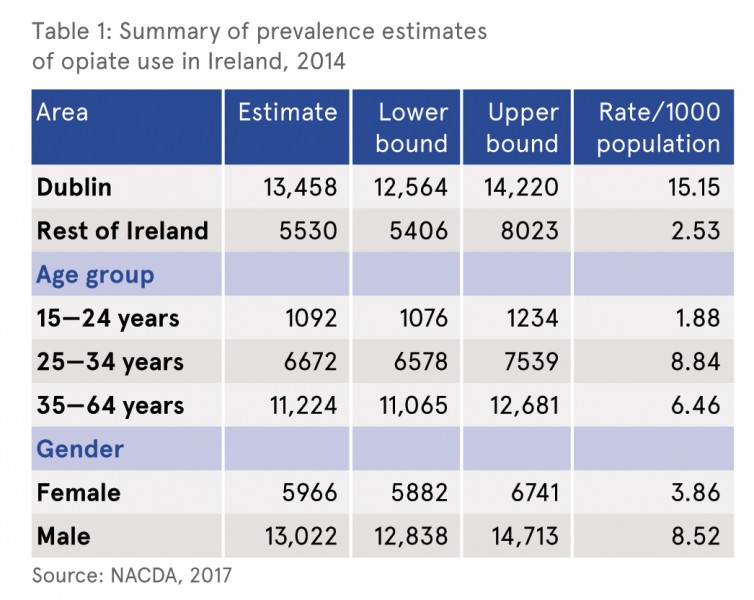Millar, Sean (2018) New estimates of problem opiate use in Ireland. Drugnet Ireland, Issue 64, Winter 2018,
| Preview | Title | Contact |
|---|---|---|
|
PDF (Issue 64, Winter 2018)
- Published Version
933kB |
In December, 2017 the National Advisory Committee on Drugs and Alcohol (NACDA) published the findings of the third study estimating the prevalence of problematic opiate use in Ireland.1 An opiate is a drug containing opium or any of its derivatives that acts as a sedative and narcotic. Examples include heroin, methadone, morphine, codeine, hydrocodone, fentanyl and tramadol. Heroin is synthesised from morphine, a naturally occurring substance extracted from the seed pod of the Asian opium poppy plant,2 and is available in three forms: a white power, a brown powder or a black sticky substance known as ‘black tar heroin’.
Capture-recapture studies
National 3-source capture-recapture (CRC) studies to provide statistically valid estimates of the prevalence of opiate drug use in the Irish population were commissioned by the National Advisory Committee on Drugs and Alcohol (NACDA) and undertaken in 20013 and 2006.4 The three data sources used were the Central Treatment List (of clients on methadone), the Hospital In-Patient Enquiry scheme and the Garda PULSE data.
A third study using the CRC method was commissioned by the NACDA in 2014.1 In this research, four data sources were utilised: (1) drug treatment clinic data; (2) information from general practice; (3) prison records; and (4) statistics provided by the Irish Probation Service. This article highlights some of the study findings.
Prevalence of opiate use
Tables 1 and 2 show prevalence estimates of opiate use in the Republic of Ireland. For the current study, data from the four sources indicated that the national prevalence estimate of opiate users in 2014 was between 18,720 and 21,454. The point estimate was 18,988, giving a rate of 6.18 per thousand population aged 15—64 years (95% CI: 6.09—6.98).
Seventy-one per cent of the estimated number of opiate users lived in Dublin. The estimates for Dublin were 13,458 (95% CI: 12,564—14,220), suggesting a population rate of 15.15 per thousand population. The corresponding figures for 2006 were 14,909 (95% CI: 13,737—16,450) with a population rate of 17.6 per thousand population. The prevalence for the rest of Ireland (excluding Dublin) was determined to be 5530 (95% CI: 5406—8023). This also represents a slight decrease when compared to estimates from 2006 (5586, 95% CI: 4399—7126). Sixty-nine per cent of opiate users in 2014 were male.
In terms of regional differences, County Sligo had the lowest prevalence of opiate use with a rate of 0.37 per thousand population (95% CI: 0.21—1.73). Other counties with prevalence rates lower than 1.0 per thousand were Donegal, Leitrim, Mayo and Monaghan.


With regard to city differences, after Dublin City, Limerick City had the highest rate of use at 8.82 per thousand population (95% CI: 7.11—13.16) followed by Waterford City (6.72, 95% CI: 5.24—15.12) and Cork City (5.67, 95% CI: 4.91—6.71). Galway City had the lowest prevalence of opiate use at 1.93 per thousand (95% CI: 1.55—2.73).
Trends
The following trends were observed in the study results:
There has been a slight decrease in opiate use both inside and outside of Dublin when compared to 2006.
The rate of opiate use among males and females aged 15—24 years has continued to decline.
More than one-half (60%) of the State’s opiate users are in the 35—64 age group, compared to less than one-third in 2006, suggesting a definite ageing cohort effect.
Conclusions
Findings from the current 4-source CRC study suggest that opiate use in Ireland has stabilised. Nevertheless, the study authors highlight that there is limited validity in making direct comparisons between studies and that none of the slight decreases observed were statistically significant.
1 Hay G, Jaddoa A, Oyston J, Webster J, Van Hout MC, Rael dos Santos A (2017) Estimating the prevalence of problematic opiate use in Ireland using indirect statistical methods. Dublin: National Advisory Committee on Drugs and Alcohol. https://www.drugsandalcohol.ie/27233/ 8
2 National Institute on Drug Abuse (2017) DrugFacts: Heroin. https://www.drugabuse.gov/publications/drugfacts/heroin
3 Kelly A, Carvalho M and Teljeur C (2003) Prevalence of opiate use in Ireland 2000–2001: a 3-source capture recapture study. Dublin: Stationery Office. https://www.drugsandalcohol.ie/5942/
4 Kelly A, Teljeur C and Carvalho M (2009) Prevalence of opiate use in Ireland 2006: a 3-source capture recapture study. Dublin: Stationery Office. https://www.drugsandalcohol.ie/12695/
A Substance use and dependence > Prevalence > Problem substance use
B Substances > Opioids (opiates)
B Substances > New (novel) psychoactive substances
B Substances > New (novel) psychoactive substances > Synthetic opioids
T Demographic characteristics > Adolescent / youth (teenager / young person)
T Demographic characteristics > Adult
T Demographic characteristics > Young adult
T Demographic characteristics > Person who injects drugs (Intravenous / injecting)
VA Geographic area > Europe > Ireland
Repository Staff Only: item control page